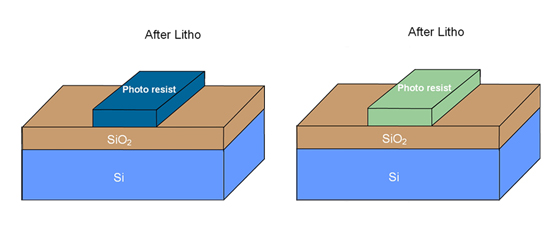The commonly used resists fall under the category of positive resists. Here, the regions exposed to light dissolve in the next stage of litho process. Thus, the pattern formed on wafer is the same as the pattern present on the mask. A few decades back, another type of resist called negative resist was used. In those resists, the regions exposed to the light will not dissolve but the regions where the light is blocked by the mask will dissolve. Typical negative photoresists are polymers with photo sensitive chemicals. In presence of light, the polymers will cross link and will be less soluble. In case of positive resists, a photo active compound which is normally not soluble in the developer is used. In presence of light, the compound changes its structure and becomes soluble.
One of the advantages of the positive resist over negative resist is that the process is relatively less sensitive to dust particles. Consider the following example. If we want to etch the material and obtain a particular structure, then for a process using a positive resist, the mask will be made as shown in the figure. For a process using a negative resist, the mask will be different, as shown in figure. The masks are called as dark field mask (for positive resist) and as light field mask (for negative resist)


FIGURE 2.5 Litho for positive and negative resists.
|